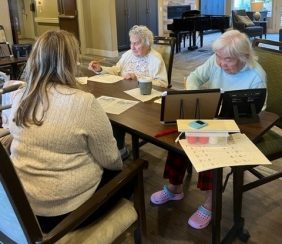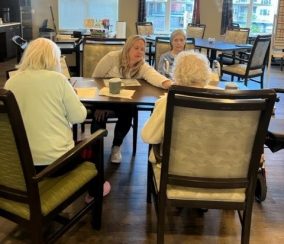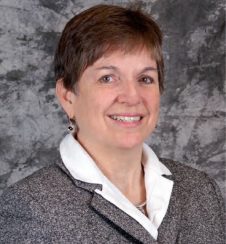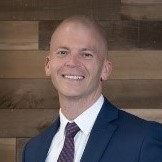Sadly, there is currently no cure for the estimated 55-plus million people living with dementia worldwide (with nearly 10 million new cases each year). There is hope, though, thanks to a process making a difference for the people and...
Sadly, there is currently no cure for the estimated 55-plus million people living with dementia worldwide (with nearly 10 million new cases each year).
There is hope, though, thanks to a process making a difference for the people and their families who live with dementia.
SAIDO (pronounced SIDE oh) is rooted in late-20th-century Japan, unwittingly started by a father who sought to help his young son improve his math skills using small-step worksheets. Today, these simple, repetitive exercises, which turned out to be highly effective for Japanese schoolchildren, is helping many seniors with memory loss by showing improvements in their symptoms.
 Sandi Semler
Sandi Semler
Sandi Semler, the social services coordinator at Penrose Harbor at Heron’s Key, in Gig Harbor, Washington, describes SAIDO as “a non-pharmacological program based on a learning intervention.” Breaking that down, SAIDO “offers mental exercises and an opportunity for engagement with staff and residents,” she told Senior Living News. For roughly 20 to 30 minutes every weekday, Semler and other “supporters” engage memory care residents in math, writing, and reading exercises.
Researched by Dr. Ryuta Kawashima of Tohoku University and Kumon Institute of Education, SAIDO Learning was developed and field tested in nursing homes in Japan. Since its wider adoption there in 2004, SAIDO has been shown in locations worldwide to interrupt the progression of symptoms of dementia. The first such trial was conducted in the U.S. in 2011, and the first communities in this country began using SAIDO in 2014.
Then, in 2022, a grant provided funds for SAIDO Learning in a few Washington state senior living communities, including Semler’s in Gig Harbor. Senior Living News recently discussed SAIDO with Semler.
SENIOR LIVING NEWS: Essentially, SAIDO is going all the way back to the so-called three R’s that we learned in first and second and third grade: reading, writing, and arithmetic. It’s repurposing, if you will, those fundamental skills that we were all taught at a very early age in a way that is helping people with dementia what? Finish that sentence: It’s helping them ____________?
 Learners and their supporter at Penrose Harbor
Learners and their supporter at Penrose Harbor
SANDI SEMLER: It’s interrupting the symptoms of dementia. There’s no cure for it, so we’re not looking to cure it. SAIDO is not academic; we’re not looking to teach them anything, but using simple exercises, math and reading done out loud every day, has been shown to increase the blood flow to the brain. And when that happens, the symptoms of dementia are interrupted, slowed down, maybe even stopped for some.
SLN: So, if it’s not teaching and you’re not a teacher, what is it that you are doing exactly?
SS: I’m called a supporter; the staff that are engaging the residents and leading them through these written and verbal exercises are called supporters. The residents are called learners. So even though they’re not really learning anything, they are engaging in meaningful conversation, they’re engaging in mental stimulating exercises.
SLN: Do we know how that helps?
SS: SAIDO was developed in Japan in the early 2000s, and lots and lots of research and analyzing and studying was done. And what they found through these brain images is that reading and counting numbers aloud will make your prefrontal cortex active. We found that it’s more active when reading fast than reading slowly. The prefrontal cortex is not very active with complicated calculations. However, it’s very active with simple calculations. These brain images have shown that when they do simple math and reading exercises aloud it increases the blood flow to the brain. And when we increase the blood flow to the brain it’s been shown to slow the symptoms of dementia.
SLN: This is fascinating. How did you learn about SAIDO, Sandi?
SS: Our facility was part of a grant project through LeadingAge Washington, and when we were honored the grant, I was asked to be a lead supporter.
SLN: What was the process for learning how to do this? Did you go through any courses or certifications?
 A Penrose Harbor supporter working with a pair of learners
A Penrose Harbor supporter working with a pair of learners
SS: Yeah, the lead supporters have a three-day training that we do. Right off the bat, probably within the first hour of watching some videos of real-life residents that have gone through the SAIDO process, I was sold on it. Just seeing the changes in the residents. We went through a three-day training, about what SAIDO is and how to facilitate at the table; we also learned more about the diagnostic testing and entering into the database. There’s more that the lead supporters do than the one-day training for supporters.
SLN: How many supporters do you have there at Penrose Harbor?
SS: We have 16. We’re in a continuing-care retirement community so we have a lot of independent-living residents that are also wanting to volunteer to be supporters.
SLN: From your experience, what kind of benefits are you seeing?
SS: We’re seeing residents engage more with each other, where they maybe hadn’t spoken or engaged with each other before. Residents are reporting that they’re happier, family members are reporting that they’re seeing positive changes in their loved ones and that their memory is increasing, they’re more social. Family members are also seeing that they’re happier.
Benefits are also with our staff. We have people from all over the community and they now have those 30 minutes of positive, meaningful engagement with residents, whereas perhaps they would have been stuck in their office and not have had that engagement. We’re really getting the whole community involved.
SLN: And the learners, your residents with dementia, do you also notice an uptick in their self-confidence?
SS: Absolutely. One of the main principles of SAIDO is positive praise and positive engagement. So, while they’re doing their worksheets, they’re constantly getting praised: ‘Great job, that looks good, wow you did amazing.’ After the worksheets are done, learners are given 100 — not 100 percent — they’re given 100 on each of their worksheets, even if they didn’t complete it, even if they didn’t get the answers right. That doesn’t matter, they’re being praised consistently and constantly for what they did. With dementia, we tend to assess and observe for what the resident can’t do any longer. With SAIDO, it’s a complete paradigm shift. Now we’re focusing on what they can do. We’re observing what they are doing, what they can do.
I do the diagnostic testing for our residents, and I was amazed at how some of these residents are doing their math problems like nobody’s business, and they’re still really great readers. So, my hope is that moving forward, with SAIDO helping, we’re really starting to see the individual for who they are and the value that they bring as a person.













